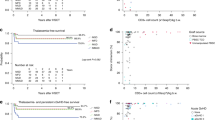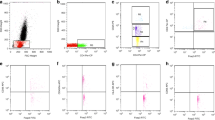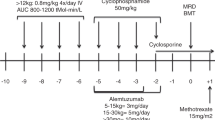Abstract
Recent insight into the pathophysiology of acute GVHD after allogeneic haematopoietic SCT has led to a growing interest in the role of natural killer (NK) cells. NK cell cytotoxicity is mainly regulated by the interaction of activating and inhibitory killer immunoglobulin-like receptors (KIRs) with their respective ligands. To investigate the impact of KIRs and their ligands on haematopoietic SCT outcome, we performed a retrospective study of 78 transfusion-dependent thalassaemia patients (median age 10 years, range 1–29 years) transplanted from an unrelated donor selected using high-resolution molecular typing for both class I and II loci after a myeloablative conditioning regimen. GVHD prophylaxis consisted of CsA, short-term MTX and anti-thymocyte globulin in all patients. We found that patients transplanted from donors homozygous for KIR haplotype A had a greater risk of developing grade II–IV acute GVHD compared with those transplanted from a donor carrying at least one B haplotype (hazard ratio=4.5, 99% confidence interval=1.2–17.1, P=0.003). Our study suggests that KIR genotyping of donor and recipient pairs could contribute to the identification of patients at high risk for developing severe complications of haematopoietic SCT and thus may help with the choice of intensity of GVHD prophylaxis.
This is a preview of subscription content, access via your institution
Access options
Subscribe to this journal
Receive 12 print issues and online access
$259.00 per year
only $21.58 per issue
Buy this article
- Purchase on Springer Link
- Instant access to full article PDF
Prices may be subject to local taxes which are calculated during checkout

Similar content being viewed by others
References
Moretta A, Locatelli F, Moretta L . Human NK cells: from HLA class I-specific killer Ig-like receptors to the therapy of acute leukemias. Immunol Rev 2008; 224: 58–69.
Trowsdale J . Genetic and functional relationships between MHC and NK receptor genes. Immunity 2001; 15: 363–374.
Bashirova AA, Martin MP, McVicar DW, Carrington M . The killer immunoglobulin-like receptor gene cluster: tuning the genome for defense. Annu Rev Genomics Hum Genet 2006; 7: 277–300.
Katz G, Gazit R, Arnon TI, Gonen-Gross T, Tarcic G, Markel G et al. MHC Class-I independent recognition of NK-activating receptor KIR2DS4. J Immunol 2004; 173: 1819–1825.
Farag SS, Bacigalupo A, Eapen M, Hurley C, Dupont B, Caligiuri MA et al. The effect of KIR ligand incompatibility on the outcome of unrelated donor transplantation: a report from the center for international blood and marrow transplant research, the European blood and marrow transplant registry and the Dutch registry. Biol Blood Marrow Transplant 2006; 12: 876–884.
Cook MA, Milligan DW, Fegan CD, Darbyshire PJ, Mahendra P, Craddock CF et al. The impact of donor KIR and patient HLA-C genotypes on outcome following HLA-identical sibling hematopoietic stem cell transplantation for myeloid leukemia. Blood 2004; 103: 1521–1526.
Hsu KC, Keever-Taylor CA, Wilton A, Pinto C, Heller G, Arkun K et al. Improved outcome in HLA-identical sibling hematopoietic stem-cell transplantation for acute myelogenous leukemia predicted by KIR and HLA genotypes. Blood 2005; 105: 4878–4884.
La Nasa G, Argiolu F, Giardini C, Pession A, Fagioli F, Caocci G et al. Unrelated bone marrow transplantation for thalassemia patients. The experience of the Italian Bone Marrow Transplant Group. Ann N Y Acad Sci 2005; 1054: 186–195.
Thomas ED, Storb R, Clift RA, Fefer A, Johnson L, Neiman PE et al. Bone-marrow transplantation (second of two parts). N Engl J Med 1975; 292: 895–902.
Uhrberg M, Valiante NM, Shum BP, Shilling HG, Lienert-Weidenbach K, Corliss B et al. Human diversity in killer cell inhibitory receptor genes. Immunity 1997; 7: 753–763.
Gagne K, Brizard G, Gueglio B, Milpied N, Herry P, Bonneville F et al. Relevance of KIR gene polymorphisms in bone marrow transplantation outcome. Hum Immunol 2002; 63: 271–280.
Lucarelli G, Giardini C, Angelucci E . Bone marrow transplantation in thalassemia. In: Winter JN (ed). Blood Stem Cell Transplantation. Kluwer Academic: Boston, MA, 1997, pp 305–315.
Zino E, Frumento G, Marktel S, Sormani MP, Ficara F, Di Terlizzi S et al. A T-cell epitope encoded by a subset of HLA-DPB1 alleles determines nonpermissive mismatches for hematologic stem cell transplantation. Blood 2004; 103: 1417–1424.
Fleischhauer K, Locatelli F, Zecca M, Orofino MG, Giardini C, De Stefano P et al. Graft rejection after unrelated donor hematopoietic stem cell transplantation for thalassemia is associated with nonpermissive HLA-DPB1 disparity in host-versus-graft direction. Blood 2006; 107: 2984–2992.
Klein JP, Rizzo JD, Zhang MJ, Keiding N . Statistical methods for the analysis and presentation of the results of bone marrow transplants, Part 2: regression modeling. Bone Marrow Transplant 2001; 28: 1001–1011.
Uhrberg M, Parham P, Wernet P . Definition of gene content for nine common group B haplotypes of the Caucasoid population: KIR haplotypes contain between seven and eleven KIR genes. Immunogenetics 2002; 54: 221–229.
Bontadini A, Testi M, Cuccia MC, Martinetti M, Carcassi C, Chiesa A et al. Distribution of killer cell immunoglobulin-like receptors genes in the Italian Caucasian population. J Transl Med 2006; 4: 44.
Norman PJ, Stephens HA, Verity DH, Chandanayingyong D, Vaughan RW . Distribution of natural killer cell immunoglobulin-like receptor sequences in three ethnic groups. Immunogenetics 2001; 52: 195.
Ludajic K, Balavarca Y, Bickeböller H, Rosenmayr A, Fae I, Fischer GF et al. KIR genes and KIR ligands affect occurrence of acute GVHD after unrelated, 12/12 HLA matched, hematopoietic stem cell transplantation. Bone Marrow Transplant 2009; 44: 97–103.
Yawata M, Yawata N, McQueen KL, Cheng NW, Guethlein LA, Rajalingam R et al. Predominance of group A KIR haplotypes in Japanese associated with diverse NK cell repertoires of KIR expression. Immunogenetics 2002; 54: 543–550.
Shlomchik WD, Couzens MS, Tang CB, McNiff J, Robert ME, Liu J et al. Prevention of graft versus host disease by inactivation of host antigen-presenting cells. Science 1999; 285: 412–415.
Zaia JA, Sun JY, Gallez-Hawkins GM, Thao L, Oki A, Lacey SF et al. The effect of single and combined activating killer immunoglobulin-like receptor genotypes on cytomegalovirus infection and immunity after hematopoietic cell transplantation. Biol Blood Marrow Transplant 2009; 15: 315–325.
Broers AE, van Der Holt R, van Esser JW, Gratama JW, Henzen-Logmans S, Kuenen-Boumeester V et al. Increased transplant-related morbidity and mortality in CMV-seropositive patients despite highly effective prevention of CMV disease after allogeneic T-cell-depleted stem cell transplantation. Blood 2000; 95: 2240–2245.
Ruggeri L, Capanni M, Casucci M, Volpi I, Tosti A, Perruccio K et al. Role of Natural Killer cell alloreactivity in HLA-mismatched hematopoietic stem cell transplantation. Blood 1999; 94: 333–339.
Ruggeri L, Capanni M, Urbani E, Perruccio K, Shlomchik WD, Tosti A et al. Effectiveness of donor Natural Killer cell alloreactivity in mismatched hematopoietic transplants. Science 2002; 295: 2097–2100.
Ruggeri L, Capanni M, Mancusi A, Martelli MF, Velardi A . The impact of donor natural killer cell alloreactivity on allogeneic hematopoietic transplantation. Transpl Immunol 2005; 14: 203–206.
La Nasa G, Littera R, Locatelli F, Giardini C, Ventrella A, Mulargia M et al. Status of donor-recipient HLA class I ligands and not the KIR genotype is predictive for the outcome of unrelated hematopoietic stem cell transplantation in beta-thalassemia patients. Biol Blood Marrow Transplant 2007; 13: 1358–1368.
Borgna-Pignatti C, Rugolotto S, De Stefano P, Zhao H, Cappellini MD, Del Vecchio GC et al. Survival and complications in patients with thalassemia major treated with transfusion and deferoxamine. Haematologica 2004; 89: 1187–1193.
Acknowledgements
We thank Anna Maria Koopmans for her assistance in preparing the paper.
Author information
Authors and Affiliations
Corresponding author
Ethics declarations
Competing interests
The authors declare no conflict of interest.
Rights and permissions
About this article
Cite this article
Littera, R., Orrù, N., Vacca, A. et al. The role of killer immunoglobulin-like receptor haplotypes on the outcome of unrelated donor haematopoietic SCT for thalassaemia. Bone Marrow Transplant 45, 1618–1624 (2010). https://doi.org/10.1038/bmt.2010.24
Received:
Revised:
Accepted:
Published:
Issue Date:
DOI: https://doi.org/10.1038/bmt.2010.24



